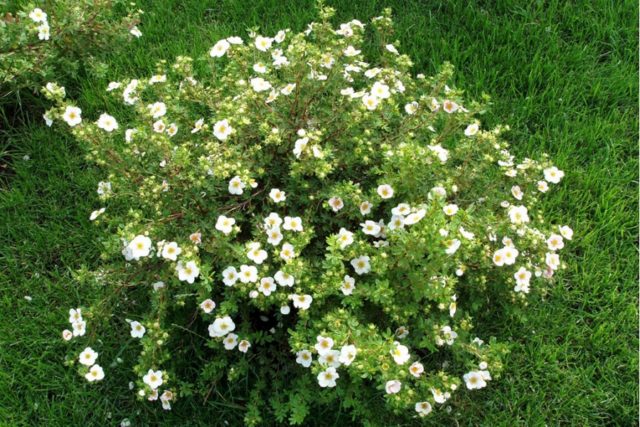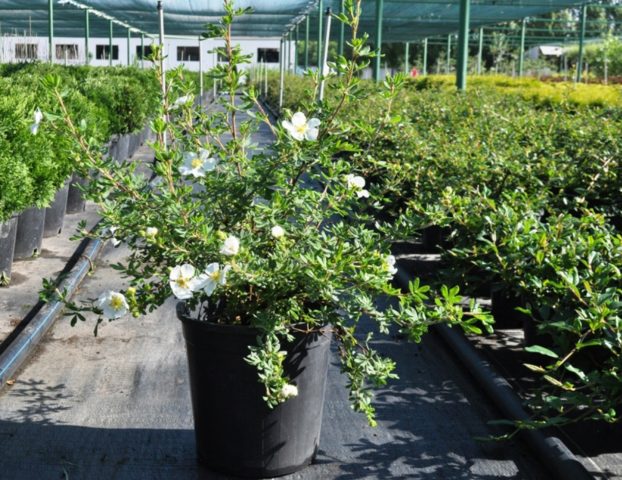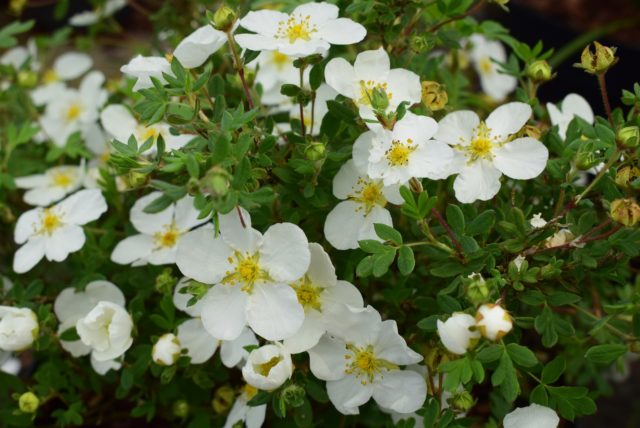Content
Cinquefoil Abbotswood or Kuril tea (also five-leafed) is a compact decorative variety of five-leafed plants, which is perfect for solitary plantings on the lawn and group compositions with conifers. The culture grows equally well both in central Russia and in the northern regions, but it also feels good in the south of the country. The shrub has a lifespan of 25-30 years.
Description of shrub Potentilla Abbotswood
Shrub cinquefoil (Potentilla fruticosa Abbotswood) is a short shrub with a rounded crown, which, when properly molded, takes on a spherical shape. The average height of the plant is 1 m, the diameter of the crown is 1-1.2 m. The first years of life, the cinquefoil shrub grows very quickly, however, then, as it approaches the upper point of growth, development slows down. The annual growth of young bushes reaches 15-20 cm in height and the same amount in width.
The culture of the Abbotswood variety blooms in June, forming small white flowers with a diameter of about 2-3 cm, in total flowering lasts until October. The leaves of the shrub are lanceolate, ovoid in shape. Their length reaches 3 cm. The color of the leaf plate in the cinquefoil of the Abbotswood shrub variety is light green with a yellowish tinge.
Cinquefoil shrub Abbotswood belongs to a fairly hardy variety - the variety safely tolerates long periods of drought and withstands a drop in temperature in winter down to -40 ° C. The advantages of the shrub also include resistance to many diseases. In particular, the Abbotswood variety does not attack powdery mildew.
Potential requirements for illumination are average. Plantings of the Abbotswood variety are photophilous, but at the same time they develop well in partial shade.
In landscape design, cinquefoil shrub Abbotswood is used to create dense hedges of a low-growing type and lining from the bottom of tall hedges from other horticultural crops. The shrub goes well with conifers and looks good in rocky gardens. Solitaire plantings are equally popular.
How the white cinquefoil Abbotswood reproduces
In the description of the cinquefoil of the Abbotswood variety, it is indicated that the plant can be propagated independently only vegetatively. The seed breeding method is used only with professional equipment.
The main methods of breeding Kuril tea include:
- breeding by divisions;
- grafting (use green cuttings);
- formation of layering.
The simplest is the reproduction of Potentilla by layering; this method does not require a lot of effort from the gardener and a significant time investment.
Reproduction by divisions
By dividing the bush, the cinquefoil is propagated as follows:
- In the fall or spring, it is necessary to dig in the plant to expose the root system.
- With the help of a shovel or ax, the part with the roots is separated from the bush. Sprinkle the mother bush with earth, covering the rhizome.
- The delen is cut off by 20-30 cm, while it is important to leave 2-3 buds.
- Then the fragment is planted in a previously prepared well. It is watered and mulched with dry needles or sawdust.
In autumn, by dividing the bush, Potentilla can be propagated only in warm regions.The separated fragment blooms on average 2-3 years after planting, the flowering Potentilla bush Abbotswood is shown in the photo below.
Green cuttings
Cutting is a fairly simple way to get a large amount of planting material. The procedure is carried out as follows:
- Starting from the end of June, you can harvest cuttings. The deadline is the last days of July. For reproduction, young shoots of the current year are selected, while the leaves do not need to be cut off from them. Cut off the branches by about 15 cm.
- The slices are dipped into a rooting stimulator for an hour.
- Then the planting material is buried in the substrate, almost completely in separate containers with soil, about 3 cm should rise above the surface. The container for cuttings should have holes on the bottom. The bottom of the containers should be covered with drainage.
- After that, containers or pots with cuttings are removed in a dark place. Over the next 2 weeks, the planting material is regularly moistened.
- On the 15th day, the plants should get stronger. They can be left indoors for the winter or planted in open ground, however, the second option is possible only when breeding the Abbotswood variety in a region with a mild climate.
Reproduction by layering
In order to form layers, it is necessary to select a healthy shoot, located close to the ground, and bend it down. A place in contact with the ground is added dropwise and pressed down from above with a heavy object so that the branch does not unbend. By the next season, the pinned shoot can be separated from the mother bush and transplanted to a new place.
Planting and caring for Potentilla Abbotswood
Preparation for planting a shrub begins in advance. Planting holes for seedlings must be dug at least 2 weeks before planting Potentilla. Planting times depend on local climatic conditions - Abbotswood seedlings can only be planted when the soil has thawed. In the south, shrub cinquefoil is planted at the end of summer.
Recommended timing
Cinquefoil shrub varieties Abbotswood can be planted both in spring in April and in autumn, no later than September. In mid-latitude conditions, it is best to land in the spring. Plants planted in the fall in harsh climates may not have time to take root before the onset of cold weather.
Site selection and soil preparation
The plant of this variety prefers loose fertile soils - in an area with compacted soil, the shrub does not develop well. When grown on poor soil, the flowering of Potentilla shrub Abbotswood is not so abundant, and the flowers themselves become smaller and have little in common with the flowers in the photo below - their petals narrow, and the core loses its yellow saturation.
The plant is insensitive to drafts, so you can plant it in open areas, especially since Potentilla loves the sun. The advantages of the Abbotswood variety include resistance to air pollution, which allows it to be planted near roads and within the city.
Not the best option would be to plant a plant on heavy clay soils - Potentilla does not tolerate stagnant moisture. The requirements for the composition of the soil in the variety are moderate. Cinquefoil Abbotswood prefers drained acidic soils, but grows well in slightly alkaline areas.
How to plant correctly
Potentilla is planted in the following sequence:
- To begin with, you need to prepare a planting pit with a depth of about 60 cm. The width of the pit depends on the size of the root system of the seedling.For group plantings, the distance between adjacent holes should be at least 1 m.If you plan to create a hedge or curb, this gap should be reduced to 50 cm.
- Drainage is placed at the bottom of the planting pit - a layer of broken clay shards, pieces of brick or pebbles about 15 cm thick.
- From above, the drainage is sprinkled with a mixture of the upper layer of garden soil, humus and sand, which are taken in a ratio of 2: 2: 1. Additionally, the soil mixture is diluted with a complex mineral fertilizer (100 g is enough).
- After that, a Potentilla seedling is placed on the soil mixture. When deepening, the root collar of a plant should be at ground level or rise above it by 2-3 cm, but no more.
- The area of the trunk circle is moderately watered and mulched with sawdust, needles or dry grass with leaves.
Growing rules
Cinquefoil shrub Abbotswood is distinguished by excellent indicators of frost resistance - in extreme cases, in especially harsh winters, the very ends of the branches can freeze the plant. With age, the resistance of the shrub to low temperatures increases. Timely feeding with mineral formulations helps to improve this indicator. Only young bushes are sheltered for the winter.
Caring for a crop of the Abbotswood variety is simple. It is rarely cut off; frequent watering is not required for the plant.
Watering
Water the Abbotswood cinquefoil in moderation. In the absence of rain, watering is carried out 2-3 times a week, but this applies only to young seedlings. After a month, watering is stopped, the plant receives a sufficient amount of moisture from the precipitation. In the hot summer, adult Potentilla bushes are watered 2-3 times per season, one bucket per plant is enough.
Top dressing
Full development of Potentilla shrub Abbotswood is possible only when planted in fertile soil. Additionally, it is necessary to feed the shrub to stimulate its flowering and strengthen it before wintering. The recommended frequency of fertilization is 1-2 times a season. In March, mineral fertilizers are applied to the soil - about 50-60 g of the complete composition. Before flowering, cinquefoil can be fed with potassium-phosphorus fertilizers according to the dosage indicated on the package.
Loosening, mulching
The mulch layer created by planting in the area of the trunk circle must be maintained throughout the season. Any material can be used:
- sawdust;
- peat;
- dry foliage;
- straw;
- needles, etc.
Loosening is carried out if the topsoil is compacted after heavy rainfall.
Pruning, shaping a bush
Obligatory annual pruning of shrub cinquefoil is not needed, however, in order to give the crown a more spherical appearance, shoots that are knocked out of the total mass can be shortened. In general, Abbotswood bushes are pruned every 3 years, cutting off about 10 cm. Rejuvenating pruning can be done even less often, with a frequency of 5 years. Shoots are shortened for this purpose by a third, the shrub cinquefoil does not like cardinal pruning.
Pests and diseases
Kuril tea of the Abbotswood variety is rarely affected by pests, and therefore does not need additional protection. The plant also gets sick infrequently, but sometimes, if the bush develops in unfavorable conditions, the cinquefoil may suffer from rust. This disease is provoked by increased soil moisture as a result of stagnant water, damp air and close proximity to diseased pines. Cinquefoil Abbotswood is treated by spraying with preparations that contain copper.
The following tools have proven themselves well:
- "Topaz";
- "Strobe";
- "Vectra";
- bordeaux liquid.
Conclusion
Cinquefoil Abbotswood is a perfect addition to any garden.The plant withstands shearing well and is harmoniously combined with many crops: perennials, coniferous shrubs and creeping species. In landscape design, the variety is usually used to create dense borders and low-growing hedges, which look especially advantageous against the background of dark conifers. Solitaire plantings of Potentilla Abbotswood look no less impressive. The culture of this variety has gained popularity among gardeners for the relative ease of formation and maintenance in general.
You can learn more about the peculiarities of growing Potentilla in Russia from the video below:











